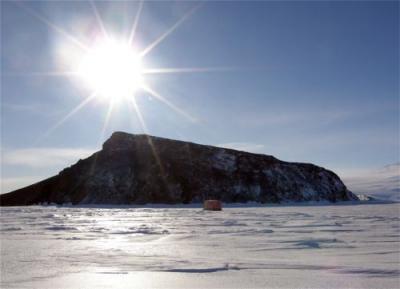Robert Falcon Scott wrote these words in the early 1900’s. I have just a taste of that feeling after spending a mere 6 hours on the ice today!
The note we received for this training: "You are scheduled to attend the Field Safety Training Program’s Sea Ice course. The purpose of this course is to teach you to assess sea ice conditions, travel safely on the sea ice, manage a sea ice survival situation, and see more of this amazing continent than is possible from the confines of McMurdo Station.”
This is what I wore: 3 pairs of socks and my "bunny” boots, 3 pairs of long underwear (light, medium, fluffy) and my wind pants, 3 insulated shirts (light, medium and fluffy), then a pile jacket, and "Big Red” the giant parka everyone wears. I wore liner gloves, insulated leather gloves, and then big fur-back gauntlet gloves over that. It was -26 F when we left station but at least it wasn’t very windy! Even with all those clothes on, I still got chilled.
We drove out to the sea ice in a Hagglunds Vehicle. Check this crazy contraption out!
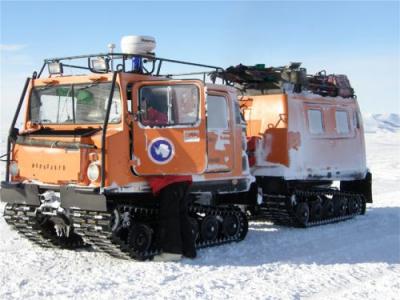
Hagglunds Vehicle
It runs on a Mercedes diesel engine and there is a drive train going to the back half of the rig so the back can push as well – it isn’t just pulled. If you have a lot of questions on vehicles, you might want to Ask Jeeves instead of me – as we have reached the limit of my knowledge!
Once we were out on the ice, our job was to evaluate sea ice cracks. There are different ways that sea ice can crack. The sea ice is rigid, but it is floating on the liquid ocean. Tides go up and down and force the ice up and down as well, so it cracks. Ocean currents can also carry sea ice above them and crash it into other sea ice. Glaciers moving onto the sea ice can push the sea ice into pressure ridges. Winds can also push sea ice chunks together and create ridges. Sometimes cracks open and close several times and may still be "active" cracks. We need to determine if we can safely cross each ice crack.

Cracks often look like raised surfaces running in a relatively straight line.
The cracks usually run a long way so they are pretty easy to see. But it is easy to "space out” and keep driving across the sea ice so you have to be aware!
When you come close to a crack, you stop your vehicle, scrape snow perpendicular to the crack to expose the ice, and then drill each level. The drills can be hand-drills (hard work) or electric motors that attach to "flights”. The first flight has a bit on it to drill into the ice. Each flight is one meter long and can attach to other flights so you can keep drilling. Today, we put up to three flights on. When we go to New Harbor later in the season, we are taking 7 flights into the field with us as some of the sea ice can be almost 7 meters (22 feet) thick where we will be diving and taking the ROV on its missions.
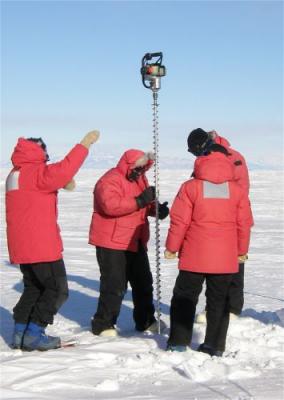
Drilling into the sea ice with an echo drill and three flights!
After you drill and bring up water, so you know you’ve gone through the sea ice, you need to measure how thick the sea ice is. If the sea ice is under 30 inches thick then you are not allowed to cross it – unless the crack is only 1/3 or less of the track length. The track length varies from vehicle to vehicle. On our Hagglund, the track length was nine feet. So we weren’t allowed to cross any cracks that were thinner than 30 inches (76 cm) unless the cracks were LESS than three feet across.
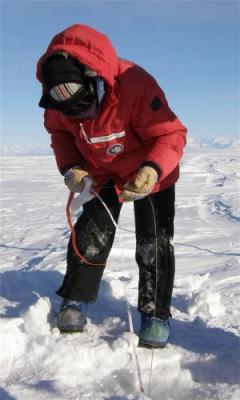
Kate measuring the thickness of the sea ice.
This may look like an ice berg but it is a beautiful block from a pressure ridge. I don't have a person next to it - but this is about 30 feet tall and shimmered in the sun.
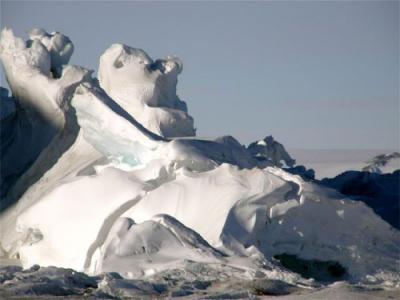
Antarctic sculpture of snow and ice.
Even though we were all cold, we still appreciated the beauty around us. This is near the new site for the Penguin Ranch. The fish hut is one of the structures that the penguin researchers will be working in. More huts and living quarters will be hauled in for this years Penguin Ranch team. They will stay out at the Ranch for about two months until the sea ice starts to melt and they need to move back to land!
